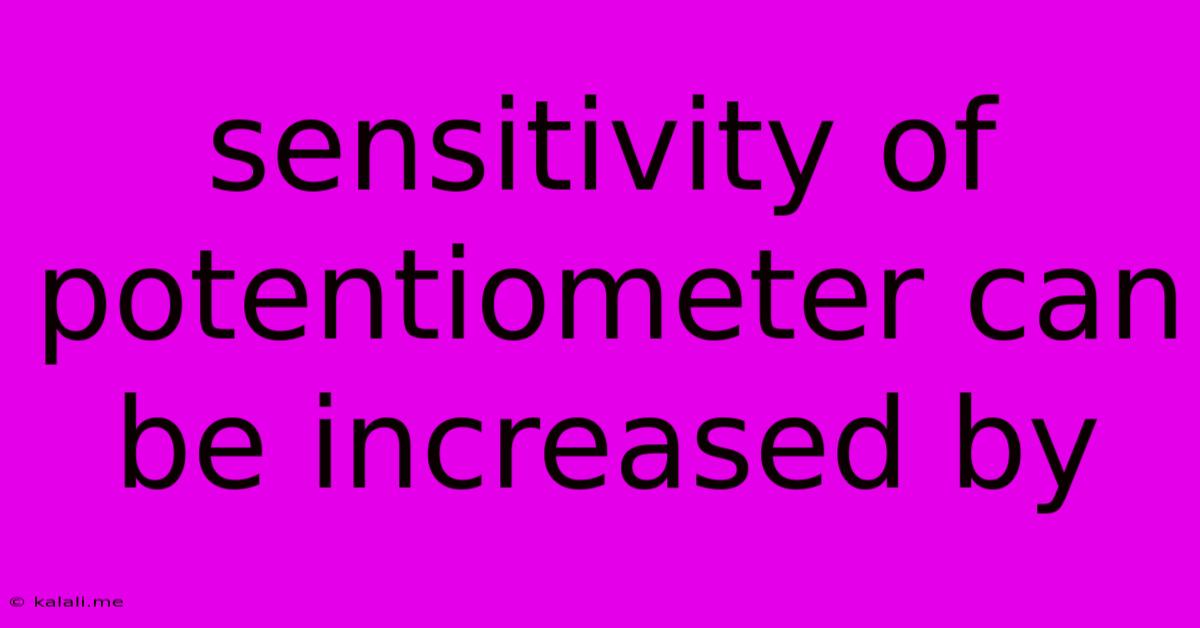Sensitivity Of Potentiometer Can Be Increased By
Kalali
Jun 13, 2025 · 3 min read

Table of Contents
Increasing the Sensitivity of a Potentiometer: Practical Techniques and Considerations
Potentiometers are ubiquitous in electronics, used for adjusting voltage, controlling current, and sensing position. However, the inherent sensitivity of a potentiometer can sometimes be insufficient for a particular application. This article explores practical methods to enhance the sensitivity of a potentiometer, along with crucial considerations for implementation. Understanding these techniques will allow you to fine-tune your circuits for optimal performance.
Understanding Potentiometer Sensitivity
Before delving into methods for improvement, let's define what we mean by potentiometer sensitivity. Sensitivity, in this context, refers to the smallest change in output voltage for a given change in the potentiometer's shaft rotation. A more sensitive potentiometer exhibits a larger output voltage change for a small shaft movement. This is crucial in applications demanding precise control or accurate measurements. Factors such as the potentiometer's resistance value and linearity directly impact its inherent sensitivity.
Techniques to Increase Potentiometer Sensitivity
Several methods can effectively increase the sensitivity of a potentiometer. These methods often involve incorporating additional circuitry or employing alternative potentiometer types.
1. Using a Gear Reduction Mechanism:
This is a purely mechanical approach. By incorporating a gear reduction system between the potentiometer's shaft and the control mechanism, a small rotation of the control input translates into a larger rotation of the potentiometer shaft. This effectively increases the resolution and, consequently, the sensitivity of the system. The gear ratio directly determines the sensitivity enhancement. A higher gear ratio means greater sensitivity.
2. Implementing a Multiplier Circuit:
Electronic amplification can significantly boost sensitivity. An operational amplifier (op-amp) configured as a non-inverting amplifier can multiply the potentiometer's output voltage. The gain of the amplifier determines the level of sensitivity increase. However, noise amplification is a potential drawback; careful op-amp selection and circuit design are critical to minimize this.
3. Utilizing a High-Resolution Potentiometer:
Choosing a potentiometer with a higher resistance value generally leads to improved sensitivity in digital applications. This is because the same voltage change across the wiper represents a smaller percentage change in the total resistance. Digital-to-analog converters (DACs) can be used to interpret the output accurately. Additionally, multi-turn potentiometers provide finer resolution compared to single-turn types.
4. Employing a Digital Potentiometer:
Digital potentiometers offer superior sensitivity compared to their analog counterparts. These devices use digital signals to control the resistance, enabling much finer adjustments. They are particularly suitable for applications needing precise and repeatable adjustments, often controlled by a microcontroller.
5. Using a Differential Amplifier:
For even greater precision, particularly in situations where small variations are crucial, a differential amplifier can be used. It amplifies the difference between two potentiometer outputs, increasing the sensitivity to small changes in the potentiometer's position. This configuration effectively minimizes the impact of noise and drift.
Considerations and Trade-offs
While these techniques enhance sensitivity, consider these factors:
- Cost: Implementing a gear reduction system or using a digital potentiometer can increase the overall cost of your project.
- Noise: Amplification circuits can amplify noise along with the desired signal, requiring careful filtering and component selection.
- Linearity: While increasing sensitivity, the linearity of the potentiometer's response might be affected, potentially requiring calibration or compensation.
- Complexity: Some techniques, such as using a differential amplifier, introduce additional circuit complexity.
Conclusion
Optimizing potentiometer sensitivity involves choosing the most appropriate technique based on your specific application and constraints. By carefully considering the available methods and their trade-offs, you can significantly enhance the performance and precision of your potentiometer-based system. Remember to select components and design the circuit meticulously to achieve the desired sensitivity while maintaining stability and minimizing noise.
Latest Posts
Latest Posts
-
Which Of The Following Statements About Government Is True
Jun 14, 2025
-
What Type Of Electromagnetic Wave Has The Longest Wavelength
Jun 14, 2025
-
Common Factors For 84 And 105
Jun 14, 2025
-
Which Color Is Not A Primary Color
Jun 14, 2025
-
What Is The Difference Between A Square And Rhombus
Jun 14, 2025
Related Post
Thank you for visiting our website which covers about Sensitivity Of Potentiometer Can Be Increased By . We hope the information provided has been useful to you. Feel free to contact us if you have any questions or need further assistance. See you next time and don't miss to bookmark.